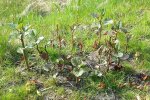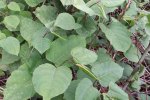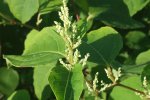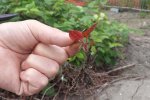
Japanese knotweed - How to control and remove it
Japanese knotweed (Fallopia japonica) is considered to be one of the most invasive exotic species. Once this plant is established, it is very difficult to get rid of. The strong growth of the Japanese knotweed allows it to displace many native plant species while its invasive root system and strong stems can cause damage to buildings, pipes and roads. So, how can we prevent the plant from spreading and control existing plants?
How to recogise the Japanese knotweed
Click on the images below to view the characteristics of this invasive plant.
What should you do if you find Japanese knotweed?
For small plots (<1 m²):
- Try to weaken the plant by cutting the stems several times per growing season. Dispose of the stems and plant cuttings in the grey bin (residual waste).
- Try to remove the shoots very carefully, making sure not to leave any roots behind.
- If necessary, a legally permitted herbicide can be applied at the end of the growing season in September.
See below under the heading ‘Control’
For large plots (>1 m²):
- As the site manager, you should determine the location of the plants.
- Make sure that these areas are not included as part of the regular mowing management, as this increases the risk of further spreading.
- Mow the places where the plants occur several times a season and dispose of the cuttings with a certified composting business.
- Check and clean clothing and machines after carrying out the work.
- Use a combination of various control methods.
- Monitor, evaluate and, if necessary, adapt the control methods.
See below under the heading ‘Control’
Find out more about the Japanese knotweed:
Origin - Where does Japanese knotweed come from?
Spreading - How does Japanese knotweed spread?
In spring, tightly clustered stems with large leaves grow from the rhizomes in a short period of time. These stems can grow between 2 to 3 metres tall depending on the location. The parts of the plant that are above-ground die again in the winter.
Spreading via rhizomes
Japanese knotweed vegetation consists mainly of female plants that do not form seeds due to the absence of pollen. The distribution of Japanese knotweed therefore takes place mainly locally via the rhizomes.
Spreading by human activity
Human activity, such as the dragging of root and stem fragments by machine mowing or the transport of soil containing parts of rhizomes and stems, poses the greatest risk of spreading the species over long distances. New plants will grow in places where these fragments end up in or on the ground.
Risks - Is Japanese knotweed harmful?
Japanese knotweed can cause nuisance in different ways.
Displacement of native species
Due to the rapid growth and the closed foliage of Japanese knotweed, native plant species are quickly displaced. A dominant presence of this invasive plant species in the vegetation also leads to a decrease in the number of invertebrates.
Damages to buildings, pipes and roads
The invasive root system and strong stems of the Japanese knotweed are able to cause damage to buildings, pipes and roads. Banks and taluses also become more unstable due to the displacement of undergrowth, especially in the winter period when the soil is exposed.
Decrease in the value of property
By investing in controlling Japanese knotweed, it may be possible to prevent the situation in the Netherlands from becoming comparable to that in England where building plots and properties decrease in value if the species is observed there.
Additional costs
The presence of Japanese knotweed means additional costs for management activities, such as monitoring, staff information, control and aftercare. Additional costs may also include precautionary measures to prevent further spread such as cleaning machines, cleaning soil, checking soil for the presence of Japanese knotweed, etc
Prevention - Can you prevent Japanese knotweed from spreading?
Prevention is the best and most cost-effective way to control Japanese knotweed.
If there is work to be done at or near to places where Japanese knotweed is found, make sure that no root or stem fragments are spread that could lead to new hotspots. Check and clean clothing and machines after carrying out the work. Prevent soil which may still contain parts of rhizomes and stems from being transported. Contaminated soil must be removed carefully, following predetermined routes.
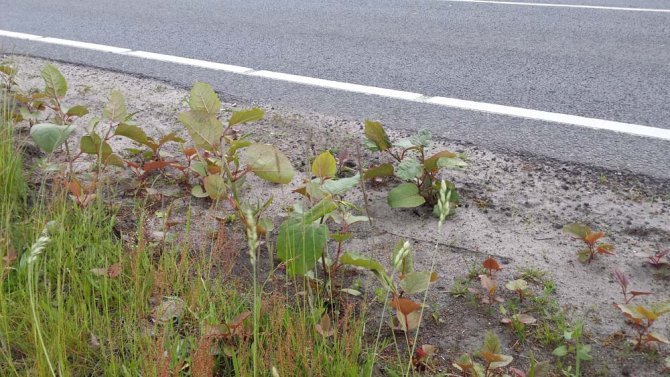
Control - How effective are control methods?
There are different methods of controlling Japanese knotweed, which vary greatly in effectiveness. There is no single method that can be identified as most suitable and the best results are achieved by combining various control methods and applying them over a longer period of time.
| Method | Effectiveness | |
|---|---|---|
| Mechanical | Mowing and removal | Low, as the root system remains intact allowing rapid regrowth. |
| Thermal | Hot water | Low, as the root system remains intact allowing rapid regrowth. |
| Chemical | Glyphosate (e.g. Roundup) | Moderate, but results may vary. Application by spraying leaves or injecting stems (permitted without dispensation as of 9 March 2018). |
| Fatty acid+germ inhibitor (e.g. Ultima) | Moderate. A germ inhibitor appears to have a long-term effect but results are highly variable. | |
| Biological | Moulds | Promising but not available in the Netherlands. |
| Japanese knotweed psyllid | Promising but not available in the Netherlands. | |
| Other | Excavation | Low, as part of the root system remains in the soil. |
| Covering | Moderate. Results are variable, even after prolonged covering. | |
| Grazing by sheep or pigs | Low, as the animals have a strong preference for other plants. |
Research with heating
WUR is working with Probos, Tree-O-Logic, contracting company Van Gelder and Van den Herik zuigtechniek to develop a method to clean contaminated soil by heating it in a mobile heating installation. Soil containing knotweed remnants is collected from various locations in Gelderland and then treated, after which it is monitored to see if the treated soil remains free of knotweed. The research runs from July 2019 to October 2019.
Support - Are you a site manager and do you need advice related to Japanese knotweed?
The Wageningen University & Research advisory team can advise and support you in dealing with invasive exotic species such as the Japanese knotweed. These consultants have extensive experience and are experts in the field of weed control and are also well-informed of the latest information about the current situation.
